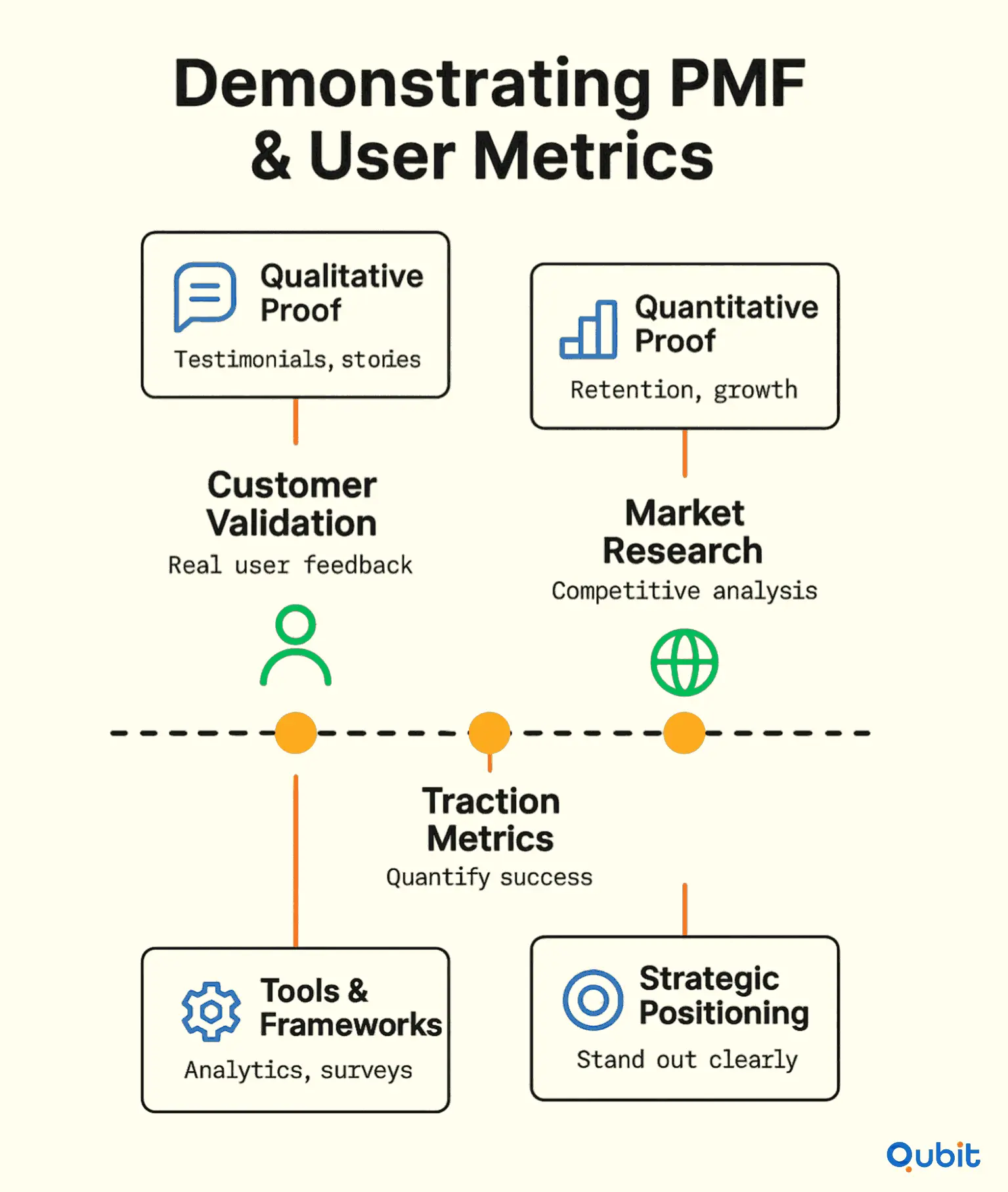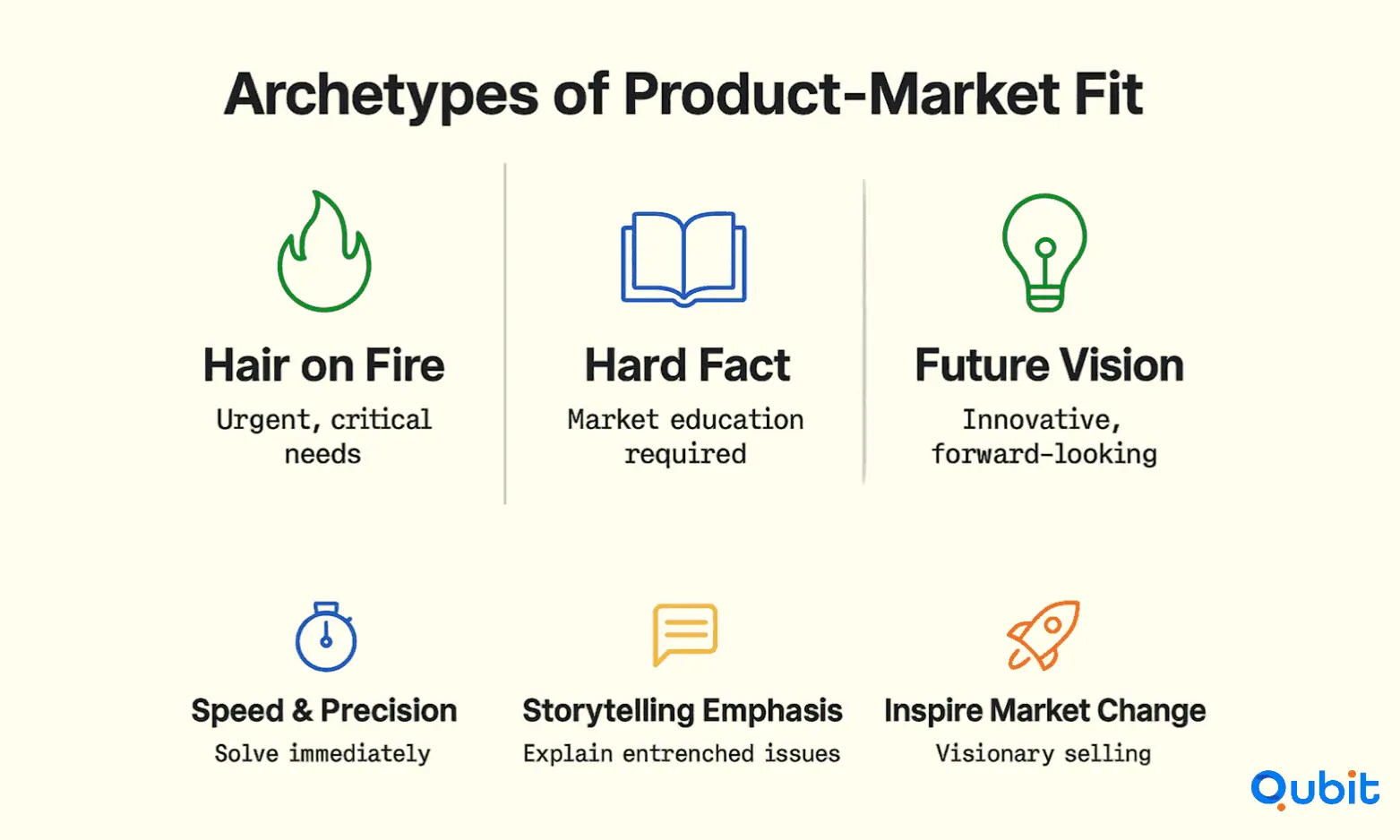Investor interest often hinges on demonstrating product–market fit (PMF) and showcasing robust user metrics. These elements validate your startup’s potential for growth and profitability, making them essential components of any pitch deck. PMF highlights the alignment between your product and market demand, while user metrics provide tangible evidence of traction and engagement.
Your analysis of product-market fit gains context when paired with insights from software startup fundraising strategies, which outlines frameworks for navigating investor financing. This post will explore actionable strategies to integrate PMF and user metrics into your pitch deck effectively.
From identifying key metrics to presenting them persuasively, we’ll cover everything you need to make a compelling case. Let’s jump right in!
The Importance of Product–Market Fit in Your Pitch Deck
PMF not only validates market demand but also reduces perceived risk, making your startup a more attractive investment opportunity. With data showing that 90% of startups fail, PMF emerges as a key differentiator for those that succeed. In fact, 70% of successful startups attribute their scalability to discovering PMF early, avoiding costly pivots later on.
Why PMF Matters for Investors
Investors prioritize PMF because it proves your product addresses a real market need. Without this validation, even the most innovative ideas risk falling flat due to lack of demand. PMF signals that your startup has the potential for scalability, which is essential for long-term growth.
Programs like Sequoia Capital’s immersion program emphasize PMF discovery for early-stage companies, underscoring its importance in building investor trust. By showcasing PMF in your pitch deck, you demonstrate that your product is not only viable but also positioned for market success.
The Correlation Between PMF and Startup Success
Startups that identify PMF early often avoid the pitfalls that lead to failure. According to research, while 90% of startups fail, those that succeed frequently credit early PMF discovery as a turning point. This correlation highlights the importance of aligning your product with market needs before scaling operations.
By integrating PMF data into your pitch deck, you provide investors with tangible proof of market demand, reducing uncertainty and increasing the likelihood of securing funding.
Key Aspects of Demonstrating Product–Market Fit and User Metrics
Achieving product–market fit (PMF) is a pivotal milestone for startups, signaling that their offering resonates deeply with the target audience. This section explores the foundational elements that validate PMF, including customer validation, traction metrics, market research, and strategic positioning.

1. Customer Validation: The Core of PMF
Customer validation is the cornerstone of proving PMF. By engaging directly with users, startups can uncover whether their product solves a genuine pain point or fulfills a pressing need. Real user testimonials and feedback provide qualitative evidence of alignment between the product and market demands. Incorporating tools like usage analytics further strengthens this validation, offering measurable insights into user engagement and satisfaction.
2. Traction Metrics: Quantifying Success
Traction metrics serve as the quantitative backbone of PMF demonstration. Metrics such as user retention rates, monthly active users, and revenue growth highlight the product’s ability to sustain interest and drive adoption. For instance, startups that achieve PMF often see a correlation with 3x–5x growth in core metrics and 20% higher Series A valuations, as highlighted by the PMF Success Correlation. These numbers not only validate market fit but also attract investor confidence.
3. Market Research: A Data-Driven Approach
Comprehensive market analysis ensures that startups understand their competitive landscape and audience preferences. Data-driven methods, such as the Sean Ellis Test, offer objective evidence of PMF by assessing user satisfaction and willingness to recommend the product. Additionally, frameworks like the Arc PMF Terrifying Questions Framework challenge assumptions, enabling founders to refine their product-market alignment through critical self-assessment.
4. Strategic Positioning: Standing Out in the Market
Strategic positioning is essential for startups to differentiate themselves and communicate their value proposition effectively. By aligning their messaging with customer needs and market trends, founders can amplify their product’s appeal. Platforms like the OpenVC website help founders connect with investors, expanding their reach and showcasing their PMF achievements to potential backers.
For startups preparing to present their PMF metrics in pitch decks, the insights provided in software pitch deck slides can help structure the narrative flow effectively. This resource ensures that PMF data is woven seamlessly into the presentation, enhancing clarity and impact.
Demonstrating PMF is not just about proving market alignment, it’s about building credibility and fostering growth. By combining qualitative validation, quantitative metrics, and strategic insights, startups can confidently showcase their product’s fit and potential.
Answering Frequent Investor Questions on PMF and Investment Timing
Achieving product–market fit (PMF) and determining the right investment timing are two pivotal concerns for investors evaluating startups. These milestones often dictate the trajectory of a company’s growth and its ability to secure funding. Addressing these questions with clarity and transparency can foster trust and confidence among stakeholders.
Understanding PMF Milestones
Investors often seek measurable indicators to assess whether a startup has achieved PMF. While PMF can vary across industries, common milestones include consistent customer retention, positive feedback loops, and scalable demand. Startups can reassure investors by presenting staged validation strategies, such as pilot programs, user testimonials, and data-driven metrics.
For SaaS businesses, metrics like Monthly Recurring Revenue (MRR), Customer Acquisition Cost (CAC), and Lifetime Value (LTV) provide quantifiable insights into PMF. A review of your performance metrics is refined by the examination found in the saas kpi pitch deck, which explains the financial indicators that resonate with investors.
Strategies for Managing Early Setbacks
Early setbacks are inevitable, but how they’re addressed can significantly impact investor confidence. Transparency is key, openly discussing challenges and pivot strategies demonstrates resilience and adaptability. For example, startups can outline how feedback from initial users informed product iterations or how market research led to a strategic pivot.
By showcasing a proactive approach to problem-solving, startups not only build trust but also highlight their commitment to long-term success. Investors value teams that can turn setbacks into opportunities for growth, as this reflects their ability to navigate uncertain market conditions effectively.
Timing Investment Decisions
The timing of investment decisions often hinges on the startup’s ability to demonstrate PMF and its readiness to scale. Investors typically look for clear signals, such as a proven revenue model, expanding customer base, and operational efficiency. Startups can strengthen their case by presenting a roadmap that aligns milestones with funding needs, ensuring that investment is timed to maximize impact.
By addressing these frequent investor questions with clarity and actionable insights, startups can position themselves as reliable and growth-oriented partners.
Distinct Archetypes of Product–Market Fit
Understanding product–market fit (PMF) requires recognizing the diverse ways it manifests across industries and customer needs. This section explores three archetypes of PMF, each reflecting unique market dynamics and opportunities for growth.

The "Hair on Fire" Archetype
This archetype is defined by urgency. Customers facing immediate, critical problems, akin to having their "hair on fire", are desperate for solutions. Products addressing these needs often experience rapid adoption and growth because the pain point is undeniable. For example, cybersecurity tools that prevent imminent data breaches or medical devices solving life-threatening conditions fall into this category.
The "Hair on Fire" archetype thrives on speed and precision. Companies targeting this PMF must deliver solutions that are both effective and easy to implement, as customers are unlikely to tolerate delays or complexity.
The "Hard Fact" Archetype
Unlike the urgency-driven "Hair on Fire" model, the "Hard Fact" archetype focuses on entrenched issues that require market education. These problems may not feel immediate but are rooted in undeniable truths, such as inefficiencies in supply chains or outdated workflows.
Products in this category often face a longer adoption curve, as customers need to be convinced of the problem’s significance and the solution’s value. For businesses pursuing this archetype, storytelling and design play a pivotal role in articulating the product’s relevance. Your presentation approach is enhanced by the perspective outlined in software pitch deck design tips, offering a balance between visual coherence and narrative impact.
The "Future Vision" Archetype
This archetype is all about reshaping markets with innovative, forward-thinking solutions. Products in this category often address needs that customers may not yet realize they have. For example, early electric vehicles or virtual reality platforms exemplify this PMF, as they aim to redefine industries over the long term.
Success in the "Future Vision" archetype requires a compelling narrative that inspires customers to imagine a better future. Companies must invest in educating their audience, building trust, and demonstrating the transformative potential of their product.
Each archetype offers distinct challenges and opportunities, but understanding which one aligns with your product is crucial for crafting effective strategies.
Building the Narrative
Start by weaving user metrics into the foundation of your pitch. Highlight how these metrics demonstrate traction, engagement, and retention. For example, showcasing customer feedback collected through platforms like Intercom, which is offered free for 1 year via OpenVC partnership, can provide tangible evidence of PMF validation. This integration not only strengthens your pitch but also underscores your commitment to understanding and addressing user needs.
Next, incorporate case studies that validate your product’s impact. These real-world examples act as proof points, illustrating how your solution has successfully addressed pain points and delivered measurable results. When paired with tailored PMF archetype strategies, these case studies can help investors visualize the scalability and sustainability of your business model.
Balancing Data and Storytelling
While data is essential, storytelling is what makes your pitch memorable. Use the metrics and case studies to craft a narrative that connects emotionally with investors. For instance, you might frame your story around a specific user journey, showing how your product transformed their experience. This approach not only humanizes your pitch but also makes the data more relatable and impactful.
Finally, ensure that your pitch deck maintains a cohesive flow. Each slide should build upon the previous one, creating a logical progression that guides investors through your vision, strategy, and execution plan. By striking the right balance between data and storytelling, you can create a pitch deck that not only informs but also inspires.
Call to Action
If you're looking for tools to gather product feedback quickly and validate PMF, consider platforms like Intercom, available free for 1 year through OpenVC. This resource can streamline your customer engagement efforts and strengthen your pitch deck narrative.
Why Product–Market Fit Is Never Static
Market dynamics are rarely predictable. Consumer behaviors change with emerging trends, technological advancements, and economic shifts. What works today may not resonate tomorrow, making it essential to revisit and refine your product’s alignment with market demands regularly.
Continuous monitoring of user feedback plays a pivotal role in this process. By actively listening to your audience, businesses can uncover opportunities for improvement, identify pain points, and ensure their offerings remain relevant.
Iteration: The Key to Sustained Success
Iteration is the backbone of maintaining product–market fit. This involves testing new features, analyzing performance metrics, and making data-driven decisions to enhance user satisfaction. Companies that embrace this iterative approach are better equipped to stay ahead of competitors and adapt to changing conditions.
For example, introducing small updates based on user feedback can lead to significant improvements in customer retention and satisfaction. These incremental changes, when consistently applied, help businesses maintain their competitive edge.
Conclusion
Validating product–market fit (PMF) early in your startup journey is essential for long-term success. Incorporating user metrics and tailored archetype frameworks ensures your strategies align with customer needs.
A clear, narrative-driven pitch deck not only communicates your vision effectively but also highlights your PMF, making it a powerful tool for securing investor interest. When you’re ready to turn traction into term sheets, tap our software fundraising assistance.
Key Takeaways
- Early demonstration of PMF is critical for reducing investor risk.
- Robust user metrics and customer validation are essential components in a pitch deck.
- Detailed market research and strategic positioning build credibility.
- Tailored PMF archetypes offer actionable frameworks for varied market challenges.
- A cohesive, data-driven narrative aligns startup vision with investor expectations.
Frequently asked Questions
What is product–market fit in startups?
When your product solves a real problem so effectively that a specific customer segment adopts it enthusiastically. Key elements are, Clear target audience, strong value proposition, and measurable user demand.






